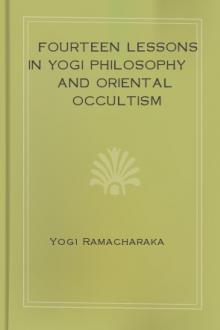A Series of Lessons in Gnani Yoga by William Walker Atkinson (non fiction books to read TXT) 📖

- Author: William Walker Atkinson
- Performer: 1428013288
Book online «A Series of Lessons in Gnani Yoga by William Walker Atkinson (non fiction books to read TXT) 📖». Author William Walker Atkinson
In the same way the soul often experiences a "heaven" in accordance with its hopes, beliefs and longings of earth-life. The "heaven" that it has longed for and believed in during its earth-life is very apt to be at least partially reproduced on the Astral plane, and the pious soul of any and all religious denominations finds itself in a "heaven" corresponding to that in which it believed during its earth-life. The Mohammedan finds his paradise; the Christian finds his; the Indian finds his—but the impression is merely an illusion created by the Mental Pictures of the soul. But the illusion tends to give pleasure to the soul, and to satisfy certain longings which in time fade away, leaving the soul free to reach out after higher conceptions and ideals. We cannot devote more space to this subject at this time, and must content ourselves with the above statements and explanations. The principal point that we desire to impress upon your minds is the fact that the "heaven-world" is not a place or state of permanent rest and abode for the disembodied soul, but is merely a place or temporary sojourn between incarnations, and thus serves as a place of rest wherein the soul may gather together its forces, energies, desires and attractions preparatory to re-birth. In this answer we have merely limited ourselves to a general statement of the states and conditions of the Astral World, or rather of certain planes of that world. The subject itself requires far more extensive treatment.
QUESTION IV: "Is Nirvana a state of the total extinction of consciousness; and is it a place, state or condition?"
ANSWER: The teaching concerning Nirvana, the final goal of the soul, has been much misunderstood, and much error has crept into the teaching even among some very worthy teachers. To conceive of Nirvana as a state of extinction of consciousness would be to fall into the error of the pessimistic school of philosophy which thinks of life and consciousness as a curse, and regards the return into a total unconsciousness as the thing to be most desired. The true teaching is that Nirvana is a state of the fullest consciousness—a state in which the soul is relieved of all the illusion of separateness and relativity, and enters into a state of Universal Consciousness, or Absolute Awareness, in which it is conscious of Infinity, and Eternity—of all places and things and time. Nirvana instead of being a state of Nothingness, is a state of "Everythingness." As the soul advances along the Path it becomes more and more aware of its connection with, relation to, and identity with the Whole. As it grows, the Self enlarges and transcends its former limited bounds. It begins to realize that it is more than the tiny separated atom that it had believed itself to be, and it learns to identify itself in a constantly increasing scale with the Universal Life. It feels a sense of Oneness in a fuller degree, and it sets its feet firmly upon the Path toward Nirvana. After many weary lives on this and other planets—in this and other Universes—after it has long since left behind it the scale of humanity, and has advanced into god-like states, its consciousness becomes fuller and fuller, and time and space are transcended in a wonderful manner. And at last the goal is attained—the battle is won—and the soul blossoms into a state of Universal Consciousness, in which Time and Place disappear and in which every place is Here; every period of Time is Now; and everything is "I." This is Nirvana.
QUESTION V: "What is that which Occultists call 'an Astral Shell,' or similar name? Is it an entity, or force, or being?"
ANSWER: When the soul passes out from the body at the moment of death it carries with it the "Astral Body" as well as the higher mental and spiritual principles (see the first three lessons in the "Fourteen Lessons"). The Astral Body is the counterpart of the material or physical body, although it is composed of matter of a much finer and ethereal nature than is the physical body. It is invisible to the ordinary eye, but may be seen clairvoyantly. The Astral Body rises from the physical body like a faint, luminous vapor, and for a time is connected with the dying physical body by a thin, vapory cord or thread, which finally breaks entirely and the separation becomes complete. The Astral Body is some time afterward discarded by the soul as it passes on to the higher planes, as we have described a few pages further back, and the abandoned Astral Body becomes an "Astral Shell," and is subject to a slow disintegration, just as is the physical body. It is no more the soul than is the physical body—it is merely a cast off garment of fine matter. It will be seen readily that it is not an entity, force or being—it is only cast off matter—a sloughed skin. It has no life or intelligence, but floats around on the lower Astral Plane until it finally disintegrates. It has an attraction toward its late physical associate—the physical body—and often returns to the place where the latter is buried, where it is sometimes seen by persons whose astral sight is temporarily awakened, when it is mistaken for a "ghost" or "spirit" of the person. These Astral Shells are often seen floating around over graveyards, battlefields, etc. And sometimes these shells coming in contact with the psychic magnetism of a medium become "galvanized" into life, and manifest signs of intelligence, which, however, really comes from the mind of the medium. At some seances these re-vitalized shells manifest and materialize, and talk in a vague, meaningless manner, the shell receiving its vitality from the body and mind of the medium instead of speaking from any consciousness of its own. This statement is not to be taken as any denial of true "spirit return," but is merely an explanation of certain forms of so-called "spiritualistic phenomena" which is well understood by advanced "spiritualists," although many seekers after psychic phenomena are in ignorance of it.
QUESTION VI: What is meant by "the Days and Nights of Brahm"; the
"Cycles"; the "Chain of Worlds", etc., etc.?
ANSWER: In Lesson Sixth, of the present series, you will find a brief mention of the "Days and Nights of Brahm"—those vast periods of the In-breathing and Out-breathing of the Creative Principle which is personified in the Hindu conception of Brahma. You will see mentioned there that universal philosophical conception of the Universal Rhythm, which manifests in a succession of periods of Universal Activity and Inactivity.
The Yogi Teachings are that all Time is manifested in Cycles. Man calls the most common form of Cyclic Time by the name of "a Day," which is the period of time necessary for the earth's revolution on its axis. Each Day is a reproduction of all previous Days, although the incidents of each day differ from those of the other—all Days are but periods of Time marked off by the revolution of the earth on its axis. And each Night is but the negative side of a Day, the positive side of which is called "day." There is really no such thing as a Day, that which we call a "Day" being simply a record of certain physical changes in the earth's position relating to its own axis.
The second phase of Cyclic Time is called by man by the name "a Month," by which is meant certain changes in the relative positions of the moon and the earth. The true month consists of twenty-eight lunar days. In this Cycle (the Month) there is also a light-time or "day," and a dark-time or "night," the former being the fourteen days of the moon's visibility, and the second being the fourteen days of the moon's invisibility.
The third phase of Cyclic Time is that which we call "a Year," by which is meant the time occupied by the earth in its revolution around the sun. You will notice that the year has its positive and negative periods, also, known as Summer and Winter.
But the Yogis take up the story where the astronomers drop it, at the Year. Beyond the Year there are other and greater phases of Cyclic Time. The Yogis know many cycles of thousands of years in which there are marked periods of Activity and Inactivity. We cannot go into detail regarding these various cycles, but may mention another division common to the Yogi teachings, beginning with the Great Year. The Great Year is composed of 360 earth years. Twelve thousand Great Years constitute what is known as a Great Cycle, which is seen to consist of 4,320,000 earth years. Seventy-one Great Cycles compose what is called a Manwantara, at the end of which the earth becomes submerged under the waters, until not a vestige of land is left uncovered. This state lasts for a period equal to 71 Great Cycles. A Kalpa is composed of 14 Manwantaras. The largest and grandest Cycle manifested is known as the Maya-Praylaya, consisting of 36,000 Kalpas when the Absolute withdraws into Itself its entire manifestations, and dwells alone in its awful Infinity and Oneness, this period being succeeded by a period equally long—the two being known as the Days and Nights of Brahm.
You will notice that each of these great Cycles has its "Day" period
and its "Night" period—its Period of Activity. and its Period of
Inactivity. From Day to Maya-Praylaya, it is a succession of Nights and
Days—Creative Activity and Creative Cessation.
The "Chain of Worlds," is that great group of planets in our own solar system, seven in number, over which the Procession of Life passes, in Cycles. From globe to globe the great wave of soul life passes in Cyclic Rhythm. After a race has passed a certain number of incarnations upon one planet, it passes on to another, and learns new lessons, and then on and on until finally it has learned all of the lessons possible on this Universe, when it passes on to another Universe, and so on, from higher to higher until the human mind is unable to even think of the grandeur of the destiny awaiting each human soul on THE PATH. The various works published by the Theosophical organizations go into detail regarding these matters, which require the space of many volumes to adequately express, but we think that we have at last indicated the general nature of the question, pointing out to the student the nature of the subject, and indicating lines for further study and investigation.
CONCLUSION.And now, dear students, we have reached the end of this series of lessons. You have followed us closely for the past four years, many of you having been with us as students from the start. We feel many ties of spiritual relationship binding you to us, and the parting, although but temporary, gives a little pang to us—a little pull upon our heart strings. We have tried to give to you a plain, practical and simple exposition of the great truths of this world-old philosophy—have endeavored to express in plain simple terms the greatest truths known to man on earth to-day, the Yogi Philosophy. And many have written us that our work has not been in vain, and that we have been the means of opening up new worlds of thought to them, and have aided them in casting off the old material sheaths





Comments (0)